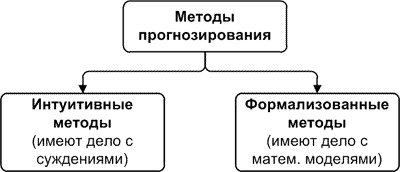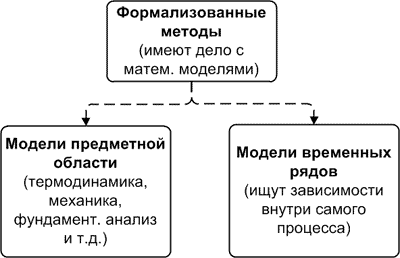Classification of forecasting methods and models
- From the sandbox
- Tutorial
I have been doing time series forecasting for more than 5 years. Last year, I defended a dissertation on the topic “ Time Series Forecasting Model for the Maximum Similarity Sample ”, however, there were decent questions after the defense. Here is one of them - a general classification of forecasting methods and models .
Usually, in the works of both domestic and English-speaking authors, they do not ask about the classification of forecasting methods and models, but simply list them. But it seems to me that today this area has grown and expanded so much that even the most general, but classification is necessary. Below is my own version of the general classification.
What is the difference between a method and a forecasting model?
The forecasting method is a sequence of actions that must be performed to obtain a forecasting model. By analogy with cooking, a method is a sequence of actions according to which a dish is prepared - that is, a forecast is made.
The forecasting model is a functional representation that adequately describes the process under study and is the basis for obtaining its future values. In the same culinary analogy, the model has a list of ingredients and their ratio, which is necessary for our dish - forecast.
The totality of the method and models form a complete recipe!
Currently, it is customary to use English abbreviations for the names of both models and methods. For example, there is a famous prediction model for auto regression integrated moving average extended (ARIMAX). This model and its corresponding method is usually called ARIMAX, and sometimes the Box-Jenkins model (method) by the name of the authors.
First we classify the methods
If you look carefully, it quickly becomes clear that the concept of “ forecasting method ” is much broader than the concept of “ forecasting model ”. In this regard, at the first stage of classification, methods are usually divided into two groups: intuitive and formalized [1].

If we recall our culinary analogy, then there you can divide all the recipes into formal recipes, that is, recorded by the number of ingredients and the method of preparation, and intuitive, that is, not recorded anywhere and obtained from the experience of the cook. When do we not use the recipe? When the dish is very simple: fry potatoes or cook dumplings - then the recipe is not needed. When else do we not use the recipe? When we want to invent something new!
Intuitive forecasting methods deal with expert judgment and judgment. Today they are often used in marketing, economics, and politics, since a system whose behavior needs to be predicted is either very complex and defies mathematical description, or very simple and does not need such a description. Details of such methods can be found in [2].
Formalized methods are forecasting methods described in the literature, as a result of which forecasting models are constructed, that is, they determine a mathematical dependence that allows us to calculate the future value of the process, that is, make a forecast.
On this, the general classification of forecasting methods in my opinion can be completed.
Next, we make a general classification of models
Here it is necessary to proceed to the classification of forecasting models. At the first stage, models should be divided into two groups: domain models and time series models.

Domain models - these are mathematical models of forecasting, for the construction of which the laws of the domain are used. For example, the model on which the weather forecast is made contains equations of fluid dynamics and thermodynamics. The forecast of population development is made on a model built on a differential equation. A prognosis of the blood sugar level of a person with diabetes is made on the basis of a system of differential equations. In a word, in such models dependencies inherent in a specific subject area are used. Such models are characterized by an individual approach to development.
Time series models are mathematical forecasting models that seek to find the dependence of the future value on the past within the process itself and on this dependence to calculate the forecast. These models are universal for various subject areas, that is, their general appearance does not change depending on the nature of the time series. We can use neural networks to predict air temperature, and then apply a similar model on neural networks to predict stock indices. These are generalized models, like boiling water, into which if you throw a product, it will be boiled regardless of its nature.
We classify time series models
It seems to me that drawing up a general classification of domain models is not possible: how many areas, so many models! However, time series models are easily amenable to simple division [3]. Time series models can be divided into two groups: statistical and structural.

In statistical models, the dependence of the future value on the past is given in the form of some equation. These include:
- regression models (linear regression, nonlinear regression);
- autoregressive models (ARIMAX, GARCH, ARDLM);
- exponential smoothing model;
- maximum similarity model;
- etc.
In structural models, the dependence of the future value on the past is specified in the form of a certain structure and the rules of transition along it. These include:
- neural network models;
- models based on Markov chains;
- models based on classification and regression trees;
- etc.
For both groups, I indicated the main, that is, the most common and detailed forecasting models. However, today there are a huge number of models for forecasting time series, and for making forecasts, for example, they began to use SVM (support vector machine) models, GA (genetic algorithm) models, and many others.
General classification
Thus, we obtained the following classification of models and forecasting methods .

References
- Tikhonov E.E. Forecasting in market conditions. Nevinnomyssk, 2006.221 s.
- Armstrong JS Forecasting for Marketing // Quantitative Methods in Marketing. London: International Thompson Business Press, 1999. P. 92-119.
- Jingfei Yang M. Sc. Power System Short-term Load Forecasting: Thesis for Ph.d degree. Germany, Darmstadt, Elektrotechnik und Informationstechnik der Technischen Universitat, 2006. 139 p.
UPD 11/15/2016.
Gentlemen, it has reached insanity! Recently I was sent for review an article for the VAK edition with reference to this entry. I draw your attention to the fact that you can’t refer to a blog in diplomas, articles, and even less so in dissertations ! If you want a link, then use this: I. Chuchueva MODEL FOR FORECASTING TIME SERIES FOR SELECTION OF MAXIMUM SIMILARITY, dissertation ... cand. those. Sciences / Moscow State Technical University. N.E. Bauman. Moscow, 2012.
